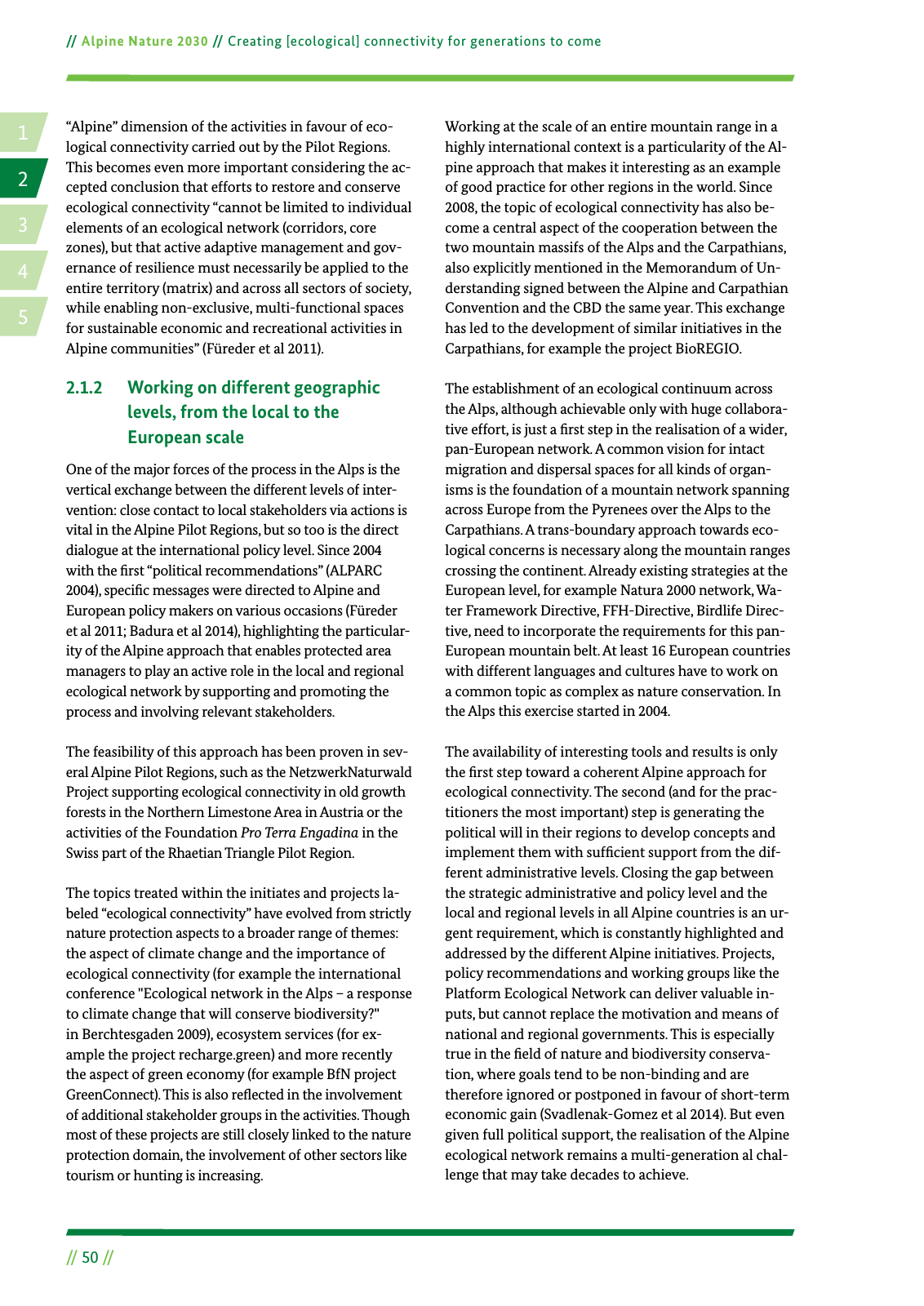14 2 5 3 50 Alpine Nature 2030 Creating ecological connectivity for generations to come Alpine dimension of the activities in favour of eco logical connectivity carried out by the Pilot Regions This becomes even more important considering the ac cepted conclusion that efforts to restore and conserve ecological connectivity cannot be limited to individual elements of an ecological network corridors core zones but that active adaptive management and gov ernance of resilience must necessarily be applied to the entire territory matrix and across all sectors of society while enabling non exclusive multi functional spaces for sustainable economic and recreational activities in Alpine communities Füreder et al 2011 2 1 2 Working on different geographic levels from the local to the European scale One of the major forces of the process in the Alps is the vertical exchange between the different levels of inter vention close contact to local stakeholders via actions is vital in the Alpine Pilot Regions but so too is the direct dialogue at the international policy level Since 2004 with the rst political recommendations ALPARC 2004 speci c messages were directed to Alpine and European policy makers on various occasions Füreder et al 2011 Badura et al 2014 highlighting the particular ity of the Alpine approach that enables protected area managers to play an active role in the local and regional ecological network by supporting and promoting the process and involving relevant stakeholders The feasibility of this approach has been proven in sev eral Alpine Pilot Regions such as the NetzwerkNaturwald Project supporting ecological connectivity in old growth forests in the Northern Limestone Area in Austria or the activities of the Foundation Pro Terra Engadina in the Swiss part of the Rhaetian Triangle Pilot Region The topics treated within the initiates and projects la beled ecological connectivity have evolved from strictly nature protection aspects to a broader range of themes the aspect of climate change and the importance of ecological connectivity for example the international conference Ecological network in the Alps a response to climate change that will conserve biodiversity in Berchtesgaden 2009 ecosystem services for ex ample the project recharge green and more recently the aspect of green economy for example BfN project GreenConnect This is also re ected in the involvement of additional stakeholder groups in the activities Though most of these projects are still closely linked to the nature protection domain the involvement of other sectors like tourism or hunting is increasing Working at the scale of an entire mountain range in a highly international context is a particularity of the Al pine approach that makes it interesting as an example of good practice for other regions in the world Since 2008 the topic of ecological connectivity has also be come a central aspect of the cooperation between the two mountain massifs of the Alps and the Carpathians also explicitly mentioned in the Memorandum of Un derstanding signed between the Alpine and Carpathian Convention and the CBD the same year This exchange has led to the development of similar initiatives in the Carpathians for example the project BioREGIO The establishment of an ecological continuum across the Alps although achievable only with huge collabora tive effort is just a rst step in the realisation of a wider pan European network A common vision for intact migration and dispersal spaces for all kinds of organ isms is the foundation of a mountain network spanning across Europe from the Pyrenees over the Alps to the Carpathians A trans boundary approach towards eco logical concerns is necessary along the mountain ranges crossing the continent Already existing strategies at the European level for example Natura 2000 network Wa ter Framework Directive FFH Directive Birdlife Direc tive need to incorporate the requirements for this pan European mountain belt At least 16 European countries with different languages and cultures have to work on a common topic as complex as nature conservation In the Alps this exercise started in 2004 The availability of interesting tools and results is only the rst step toward a coherent Alpine approach for ecological connectivity The second and for the prac titioners the most important step is generating the political will in their regions to develop concepts and implement them with suf cient support from the dif ferent administrative levels Closing the gap between the strategic administrative and policy level and the local and regional levels in all Alpine countries is an ur gent requirement which is constantly highlighted and addressed by the different Alpine initiatives Projects policy recommendations and working groups like the Platform Ecological Network can deliver valuable in puts but cannot replace the motivation and means of national and regional governments This is especially true in the eld of nature and biodiversity conserva tion where goals tend to be non binding and are therefore ignored or postponed in favour of short term economic gain Svadlenak Gomez et al 2014 But even given full political support the realisation of the Alpine ecological network remains a multi generation al chal lenge that may take decades to achieve

Hinweis: Dies ist eine maschinenlesbare No-Flash Ansicht.
Klicken Sie hier um zur Online-Version zu gelangen.
Klicken Sie hier um zur Online-Version zu gelangen.